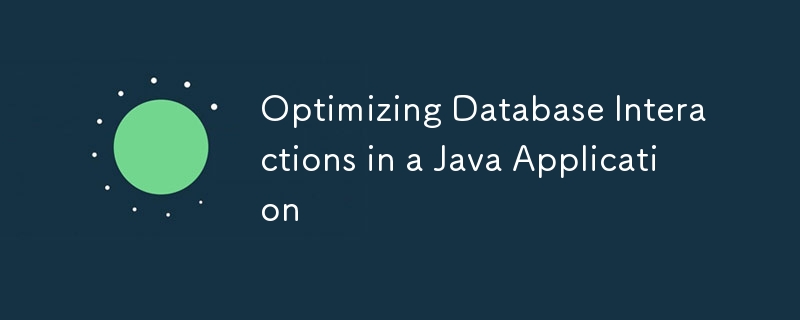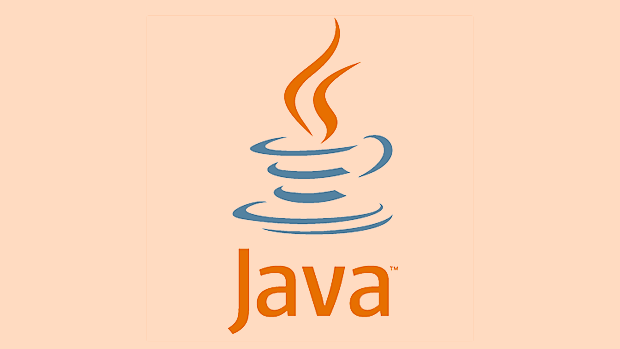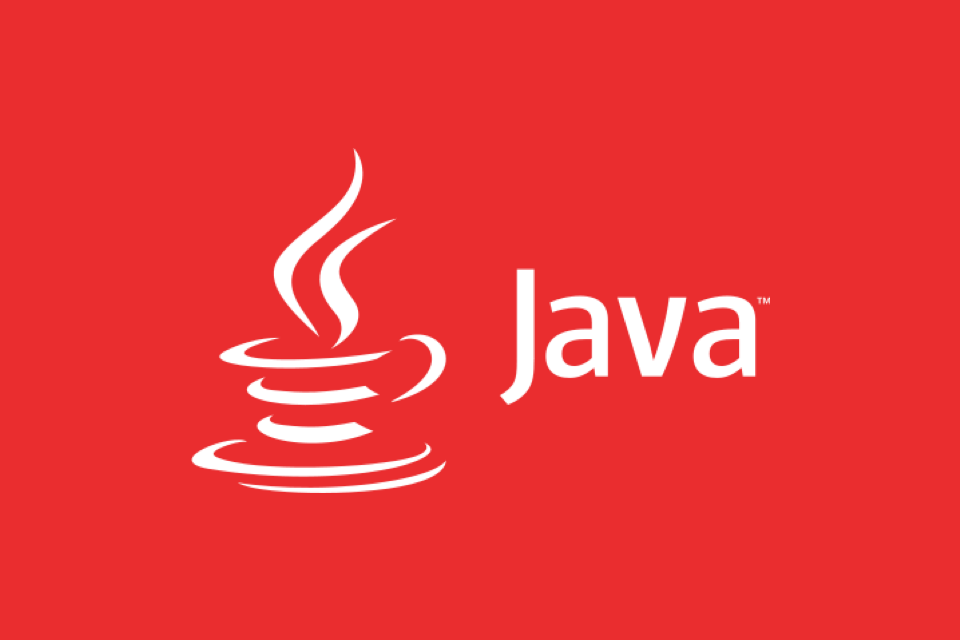Optimizing Database Interactions in a Java Application
Jul 27, 2025 am 02:32 AMUse connection pooling with HikariCP to reuse database connections and reduce overhead. 2. Use PreparedStatement to prevent SQL injection and improve query performance. 3. Fetch only required data by selecting specific columns and applying filters and pagination. 4. Use batch operations to reduce round trips when inserting or updating multiple records. 5. Use ORM tools like Hibernate wisely by avoiding N 1 queries, enabling caching, and using lazy loading and DTO projections. 6. Keep transactions short and avoid external calls within transactions to reduce locking. 7. Monitor queries with logging and EXPLAIN plans, and add appropriate indexes. 8. Use read replicas to offload read queries and improve scalability under heavy read loads.

When building Java applications that rely on databases, performance and reliability heavily depend on how efficiently you interact with the database. Poorly optimized database operations can lead to slow response times, resource exhaustion, and scalability issues. Here’s how to optimize database interactions in a typical Java application.

1. Use Connection Pooling
Opening a new database connection for every operation is expensive. Instead, reuse existing connections via a connection pool.
Why it matters:

- Establishing a connection involves network handshake and authentication.
- Pools like HikariCP, Apache DBCP, or C3P0 manage a reusable set of connections.
Best practices:
- Use HikariCP (fastest and widely adopted).
- Configure pool size based on workload (e.g., 10–20 for moderate apps).
- Set timeouts and leak detection to avoid resource issues.
HikariConfig config = new HikariConfig();
config.setJdbcUrl("jdbc:mysql://localhost:3306/mydb");
config.setUsername("user");
config.setPassword("pass");
config.setMaximumPoolSize(15);
HikariDataSource dataSource = new HikariDataSource(config);2. Use PreparedStatement and Avoid String Concatenation
Dynamic queries built via string concatenation are vulnerable to SQL injection and are not cached by the database.

Use PreparedStatement:
- Precompiled SQL improves performance.
- Prevents SQL injection.
- Supports parameter placeholders (
?).
String sql = "SELECT * FROM users WHERE age > ?";
try (PreparedStatement stmt = connection.prepareStatement(sql)) {
stmt.setInt(1, 25);
ResultSet rs = stmt.executeQuery();
// process results
}Bonus: Reuse prepared statements when executing the same query multiple times.
3. Fetch Only What You Need
Avoid SELECT * and fetch unnecessary columns or rows.
Optimize queries:
- Select only required columns.
- Use
LIMITor pagination (OFFSET,FETCH NEXT) for large datasets. - Apply filters early in the query.
-- Bad SELECT * FROM users; -- Good SELECT id, name, email FROM users WHERE active = 1 LIMIT 100;
In Java, map results efficiently using tools like JDBC RowMapper, JPA, or jOOQ.
4. Batch Operations for Bulk Data
Inserting or updating many records one-by-one causes round-trip overhead.
Use batch processing:
- Group multiple operations into a single batch.
- Reduces network round trips.
String sql = "INSERT INTO logs (message, created_at) VALUES (?, ?)";
try (PreparedStatement stmt = connection.prepareStatement(sql)) {
for (LogEntry entry : entries) {
stmt.setString(1, entry.getMessage());
stmt.setTimestamp(2, entry.getTimestamp());
stmt.addBatch(); // Add to batch
}
stmt.executeBatch(); // Execute all at once
}Note: Tune batch size (e.g., 50–100) to balance memory and performance.
5. Leverage ORM Tools Wisely (e.g., Hibernate)
ORMs like Hibernate simplify database interactions but can hurt performance if misused.
Optimization tips:
- Avoid N 1 query problems (use
JOIN FETCHor@EntityGraph). - Enable second-level cache for frequently read data.
- Use lazy loading appropriately—don’t load large associations unless needed.
- Consider using DTO projections instead of full entities when only a few fields are needed.
// Prevent N 1
@Query("SELECT u FROM User u JOIN FETCH u.profile WHERE u.active = true")
List<User> findActiveUsersWithProfiles();6. Optimize Transactions
Long-running transactions lock resources and reduce concurrency.
Best practices:
- Keep transactions as short as possible.
- Use
@Transactional(in Spring) with appropriate propagation and isolation levels. - Avoid user input or external calls inside a transaction.
@Service
@Transactional
public class UserService {
public void updateUserProfile(Long id, String email) {
User user = userRepository.findById(id);
user.setEmail(email);
userRepository.save(user); // Auto-committed
}
}7. Monitor and Tune Queries
Even well-written code can suffer from slow queries due to missing indexes or poor execution plans.
What to do:
- Enable database query logging (e.g.,
log slow queriesin MySQL). - Use tools like EXPLAIN to analyze query plans.
- Add indexes on frequently queried columns (but not too many—index maintenance has cost).
Example:
EXPLAIN SELECT * FROM users WHERE email = 'user@example.com';
8. Use Read Replicas for Heavy Read Workloads
If your app has heavy read traffic, offload SELECT queries to read replicas.
How:
- Configure multiple data sources (read and write).
- Route read operations to replicas, writes to the primary.
In Spring, you can use AbstractRoutingDataSource to switch between data sources.
Optimizing database interactions in Java isn’t just about writing fast code—it’s about smart resource management, secure practices, and understanding how your application and database work together. With connection pooling, proper query design, batching, and ORM tuning, you can significantly boost performance and scalability.
Basically, go fast, stay safe, and keep an eye on what the database is actually doing.
The above is the detailed content of Optimizing Database Interactions in a Java Application. For more information, please follow other related articles on the PHP Chinese website!

Hot AI Tools

Undress AI Tool
Undress images for free

Undresser.AI Undress
AI-powered app for creating realistic nude photos

AI Clothes Remover
Online AI tool for removing clothes from photos.

Clothoff.io
AI clothes remover

Video Face Swap
Swap faces in any video effortlessly with our completely free AI face swap tool!

Hot Article

Hot Tools

Notepad++7.3.1
Easy-to-use and free code editor

SublimeText3 Chinese version
Chinese version, very easy to use

Zend Studio 13.0.1
Powerful PHP integrated development environment

Dreamweaver CS6
Visual web development tools

SublimeText3 Mac version
God-level code editing software (SublimeText3)
 VSCode settings.json location
Aug 01, 2025 am 06:12 AM
VSCode settings.json location
Aug 01, 2025 am 06:12 AM
The settings.json file is located in the user-level or workspace-level path and is used to customize VSCode settings. 1. User-level path: Windows is C:\Users\\AppData\Roaming\Code\User\settings.json, macOS is /Users//Library/ApplicationSupport/Code/User/settings.json, Linux is /home//.config/Code/User/settings.json; 2. Workspace-level path: .vscode/settings in the project root directory
 How to handle transactions in Java with JDBC?
Aug 02, 2025 pm 12:29 PM
How to handle transactions in Java with JDBC?
Aug 02, 2025 pm 12:29 PM
To correctly handle JDBC transactions, you must first turn off the automatic commit mode, then perform multiple operations, and finally commit or rollback according to the results; 1. Call conn.setAutoCommit(false) to start the transaction; 2. Execute multiple SQL operations, such as INSERT and UPDATE; 3. Call conn.commit() if all operations are successful, and call conn.rollback() if an exception occurs to ensure data consistency; at the same time, try-with-resources should be used to manage resources, properly handle exceptions and close connections to avoid connection leakage; in addition, it is recommended to use connection pools and set save points to achieve partial rollback, and keep transactions as short as possible to improve performance.
 Mastering Dependency Injection in Java with Spring and Guice
Aug 01, 2025 am 05:53 AM
Mastering Dependency Injection in Java with Spring and Guice
Aug 01, 2025 am 05:53 AM
DependencyInjection(DI)isadesignpatternwhereobjectsreceivedependenciesexternally,promotingloosecouplingandeasiertestingthroughconstructor,setter,orfieldinjection.2.SpringFrameworkusesannotationslike@Component,@Service,and@AutowiredwithJava-basedconfi
 python itertools combinations example
Jul 31, 2025 am 09:53 AM
python itertools combinations example
Jul 31, 2025 am 09:53 AM
itertools.combinations is used to generate all non-repetitive combinations (order irrelevant) that selects a specified number of elements from the iterable object. Its usage includes: 1. Select 2 element combinations from the list, such as ('A','B'), ('A','C'), etc., to avoid repeated order; 2. Take 3 character combinations of strings, such as "abc" and "abd", which are suitable for subsequence generation; 3. Find the combinations where the sum of two numbers is equal to the target value, such as 1 5=6, simplify the double loop logic; the difference between combinations and arrangement lies in whether the order is important, combinations regard AB and BA as the same, while permutations are regarded as different;
 Troubleshooting Common Java `OutOfMemoryError` Scenarios
Jul 31, 2025 am 09:07 AM
Troubleshooting Common Java `OutOfMemoryError` Scenarios
Jul 31, 2025 am 09:07 AM
java.lang.OutOfMemoryError: Javaheapspace indicates insufficient heap memory, and needs to check the processing of large objects, memory leaks and heap settings, and locate and optimize the code through the heap dump analysis tool; 2. Metaspace errors are common in dynamic class generation or hot deployment due to excessive class metadata, and MaxMetaspaceSize should be restricted and class loading should be optimized; 3. Unabletocreatenewnativethread due to exhausting system thread resources, it is necessary to check the number of threads, use thread pools, and adjust the stack size; 4. GCoverheadlimitexceeded means that GC is frequent but has less recycling, and GC logs should be analyzed and optimized.
 python pytest fixture example
Jul 31, 2025 am 09:35 AM
python pytest fixture example
Jul 31, 2025 am 09:35 AM
fixture is a function used to provide preset environment or data for tests. 1. Use the @pytest.fixture decorator to define fixture; 2. Inject fixture in parameter form in the test function; 3. Execute setup before yield, and then teardown; 4. Control scope through scope parameters, such as function, module, etc.; 5. Place the shared fixture in conftest.py to achieve cross-file sharing, thereby improving the maintainability and reusability of tests.
 Understanding the Java Virtual Machine (JVM) Internals
Aug 01, 2025 am 06:31 AM
Understanding the Java Virtual Machine (JVM) Internals
Aug 01, 2025 am 06:31 AM
TheJVMenablesJava’s"writeonce,runanywhere"capabilitybyexecutingbytecodethroughfourmaincomponents:1.TheClassLoaderSubsystemloads,links,andinitializes.classfilesusingbootstrap,extension,andapplicationclassloaders,ensuringsecureandlazyclassloa
 How to work with Calendar in Java?
Aug 02, 2025 am 02:38 AM
How to work with Calendar in Java?
Aug 02, 2025 am 02:38 AM
Use classes in the java.time package to replace the old Date and Calendar classes; 2. Get the current date and time through LocalDate, LocalDateTime and LocalTime; 3. Create a specific date and time using the of() method; 4. Use the plus/minus method to immutably increase and decrease the time; 5. Use ZonedDateTime and ZoneId to process the time zone; 6. Format and parse date strings through DateTimeFormatter; 7. Use Instant to be compatible with the old date types when necessary; date processing in modern Java should give priority to using java.timeAPI, which provides clear, immutable and linear






